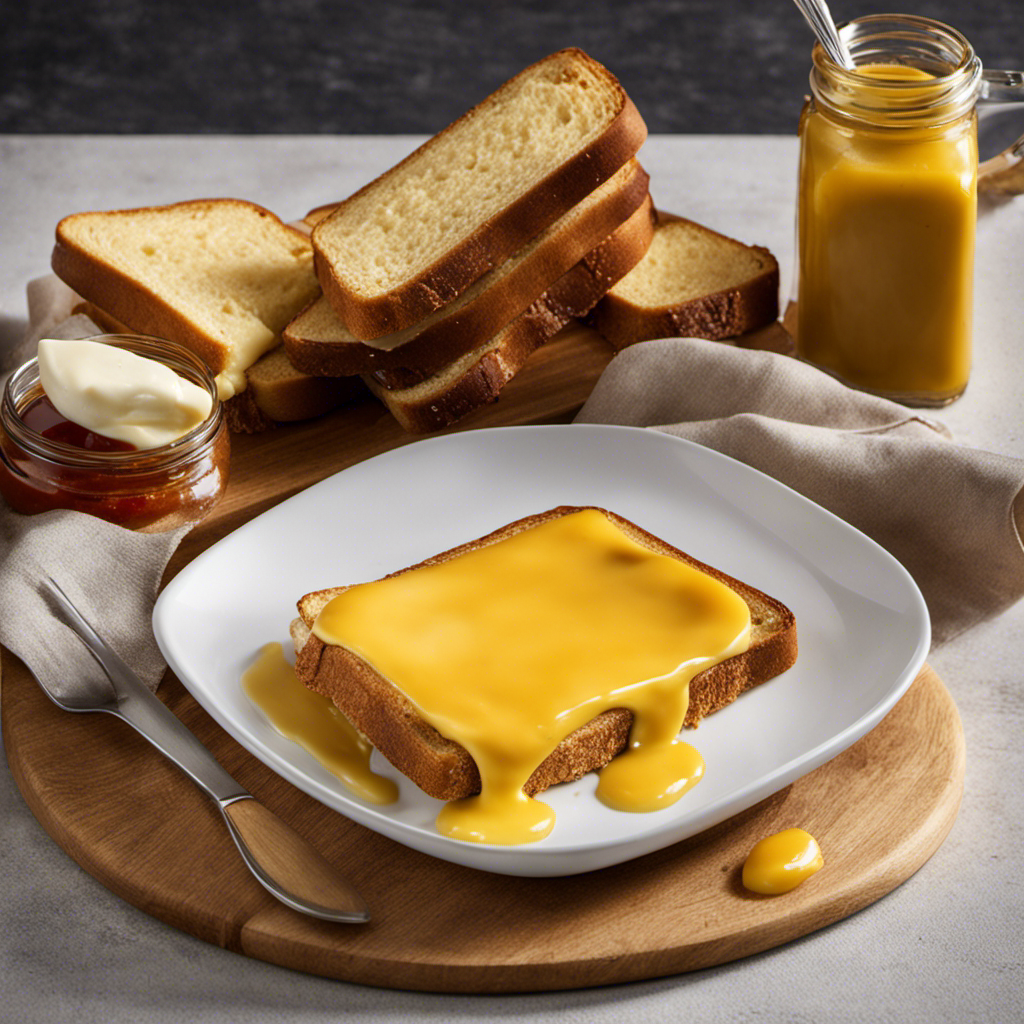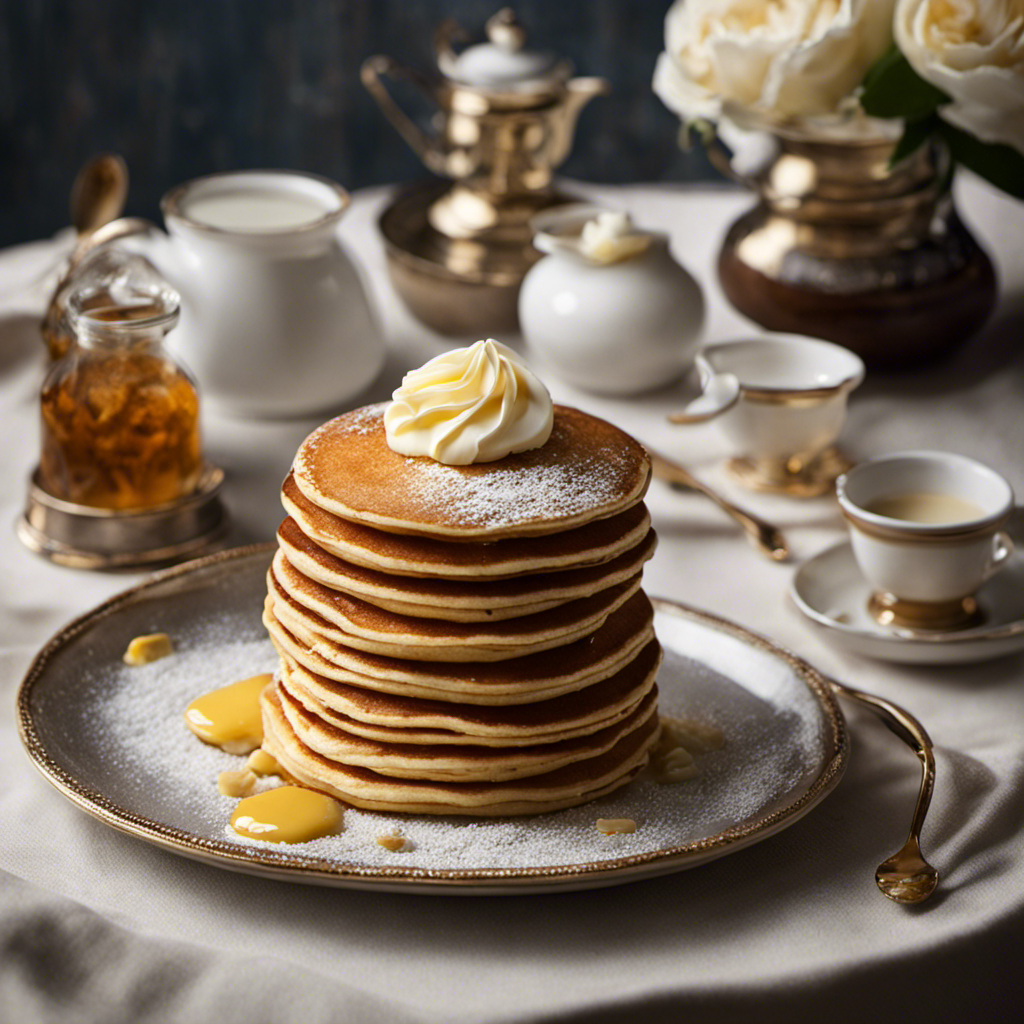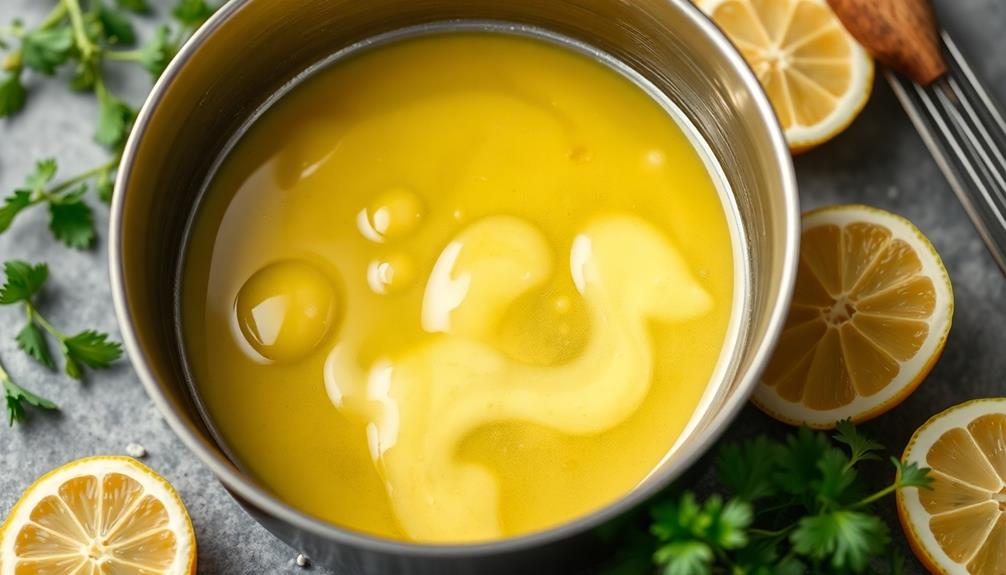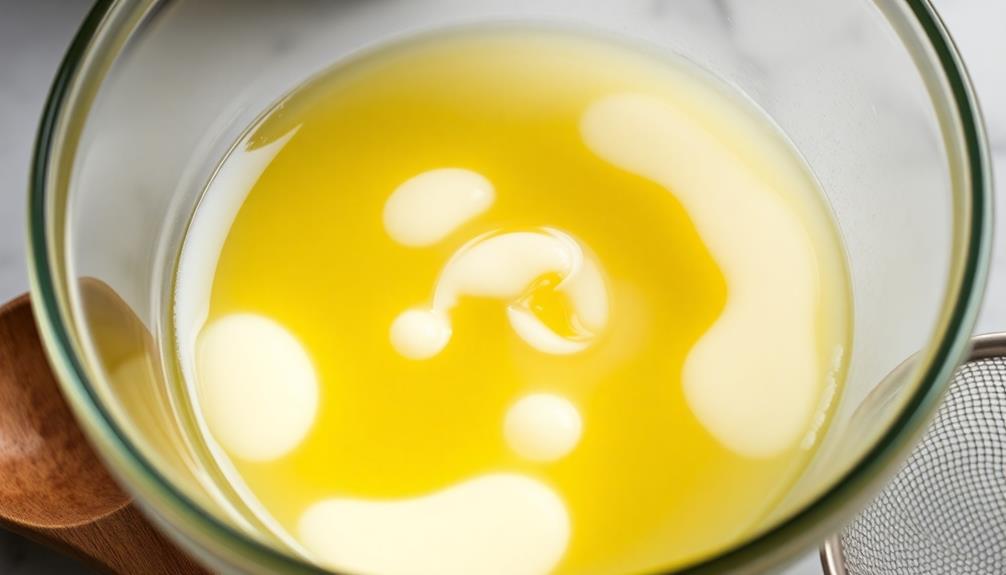I adore butter. Its richness, creaminess, and the flavorful enhancement it brings to countless recipes are simply unparalleled.
But if you’re watching your carb intake, you might be wondering just how many carbs are in butter. Well, let me tell you, it’s not as much as you might think!
In this article, we’ll dive into the world of carbohydrates and uncover the truth about butter. From unsalted to salted, we’ll explore different types of butter and even discuss low-carb alternatives.
So, get ready to butter up your knowledge and make informed choices for your low-carb lifestyle!
Key Takeaways
- Butter is primarily made up of fat and has minimal carbohydrates.
- Butter is low in carbs but high in saturated fat.
- Monitoring butter intake is important for a low-carb diet.
- Choosing butter with zero carbs helps in maintaining a low-carb diet.
Understanding Carbohydrates
Carbs are a type of nutrient that our bodies need for energy. Understanding carb absorption and their impact on insulin levels is crucial for maintaining a balanced diet.
When we eat carbohydrates, our bodies break them down into glucose, which is then absorbed into the bloodstream. Different types of carbs are digested and absorbed at different rates.
Simple carbohydrates, like those found in sugar and refined grains, are quickly absorbed, leading to a rapid increase in blood sugar levels and a subsequent spike in insulin production.
On the other hand, complex carbohydrates, such as those found in whole grains and vegetables, are absorbed more slowly, resulting in a gradual rise in blood sugar and a more controlled release of insulin.
The Nutritional Profile of Butter
You might be surprised to learn that butter contains various nutrients and can be part of a balanced diet. While it is commonly known for its high fat content, butter also provides essential vitamins and minerals.
Grass-fed butter, in particular, offers additional benefits. Studies have shown that grass-fed cows produce milk with higher levels of omega-3 fatty acids, which can help reduce inflammation and improve heart health. Grass-fed butter also contains higher levels of conjugated linoleic acid (CLA), a type of fat that may have potential health benefits, including weight management and reducing the risk of certain diseases.
Incorporating grass-fed butter into your diet in moderation can be a way to enjoy its nutritional benefits.
Now, let’s delve into the topic of carbohydrates in unsalted butter.
Carbohydrates in Unsalted Butter
When it comes to the carb content of butter, it’s important to understand that butter is primarily made up of fat and contains minimal carbohydrates. On average, unsalted butter contains less than 1 gram of carbohydrates per tablespoon.
However, it’s worth noting that while butter is low in carbs, it is high in saturated fat, which can have implications for our health if consumed in excess.
Carb Content of Butter
Butter contains a significant amount of carbs, so it’s important to watch your intake if you’re following a low-carb diet. However, understanding the glycemic index can help you make informed choices about the types of carbs you consume.
When it comes to butter and weight loss, it’s important to consider the following:
- Butter has a very low glycemic index, which means it doesn’t cause a rapid spike in blood sugar levels.
- The carb content in butter is minimal, with less than 1 gram of carbs per tablespoon.
- Consuming butter in moderation can be a part of a balanced low-carb diet.
Considering these factors, incorporating butter into your low-carb diet can be done responsibly. However, it’s essential to also consider the health implications of butter and make sure to balance it with other nutritious foods.
Health Implications of Butter
The consumption of butter in large amounts may have negative health implications. While butter can provide some health benefits, such as being a good source of vitamins A and D, it is also high in saturated fat, which can increase the risk of heart disease. Saturated fat raises LDL cholesterol levels, which can lead to clogged arteries and an increased risk of cardiovascular problems.
It is recommended to limit saturated fat intake to less than 10% of total daily calories. Butter should be consumed in moderation, and it is important to consider alternative options, such as olive oil or avocado, which are healthier sources of fat.
It is always best to consult with a healthcare professional for personalized advice on dietary choices and potential risks.
Carbohydrates in Salted Butter
When it comes to comparing the carbohydrate content of butter and margarine, there are a few key points to consider.
Firstly, butter contains zero carbohydrates, making it a great choice for those following a low-carb or ketogenic diet.
On the other hand, margarine can vary in its carbohydrate content depending on the brand and type, so it’s important to read the nutrition labels carefully.
Lastly, when it comes to the impact on a keto diet, butter is generally preferred over margarine due to its higher fat content and lower carb count.
Carb Content Comparison
To compare carb content, you’ll want to look at the nutrition labels of different food products. When it comes to comparing the carb content of different types of butter, such as ghee and vegan butter, here’s what you need to know:
-
Ghee: Ghee is a type of clarified butter commonly used in Indian cuisine. It is made by heating butter and removing the milk solids. Ghee contains virtually no carbohydrates, making it a great option for those following a low-carb or ketogenic diet.
-
Vegan Butter: Vegan butter is a plant-based alternative to traditional butter. While the carb content can vary depending on the brand, many vegan butter products are made from oils and contain little to no carbohydrates.
Comparing the carb content of ghee and vegan butter can help you make an informed choice based on your dietary needs and preferences.
Now, let’s explore how these butter alternatives can impact a keto diet.
Impact on Keto Diet
If you’re following a keto diet, it’s important to consider how ghee and vegan butter can affect your progress. One of the main benefits of the ketogenic diet is its ability to help you reach and maintain a state of ketosis, where your body burns fat for fuel instead of carbohydrates.
Traditional butter contains trace amounts of carbs, generally less than 1 gram per tablespoon, which makes it a suitable option for most keto diets. However, if you’re looking for carb-free butter alternatives, ghee and vegan butter can be excellent options.
Ghee, a clarified butter with the milk solids removed, is virtually carb-free and rich in healthy fats. Vegan butter, made from plant-based oils, is also typically carb-free and can provide a similar taste and texture to traditional butter.
Both ghee and vegan butter can be used as substitutes in your favorite keto recipes without compromising your progress. So, if you’re on a keto diet and looking for carb-free butter options, give ghee or vegan butter a try.
Butter Vs Margarine
When it comes to butter substitutes, one popular option is margarine. Margarine is made from vegetable oils and often contains lower amounts of saturated fats compared to butter. This can be beneficial for those looking to reduce their cholesterol intake. However, it’s important to note that not all margarines are created equal. Some may still contain trans fats, which can raise bad cholesterol levels.
In addition to margarine, there are other butter substitutes available, such as ghee and avocado oil spreads. Ghee is a clarified butter that has had its milk solids removed, making it suitable for lactose-intolerant individuals. Avocado oil spreads are made from avocado oil, which is rich in heart-healthy monounsaturated fats.
Transition: Now that we’ve discussed butter substitutes and their impact on cholesterol, let’s delve into comparing the carb content of different types of butter.
Comparing Carbs in Different Types of Butter
You should check the labels to compare the carbs in different types of butter. When it comes to flavored butter, it’s important to be aware of the added ingredients that may increase the carb content. Flavored butters like garlic or herb-infused varieties often contain additional seasonings, which can contribute to higher carb levels.
It’s always a good idea to read the nutrition information on the packaging to make an informed decision. Additionally, it’s worth noting that butter is a high-fat food and can impact cholesterol levels. While butter does contain small amounts of carbs, its main concern is its saturated fat content. High intake of saturated fat can raise cholesterol levels, so it’s important to consume butter in moderation and maintain a balanced diet overall.
How Carbs in Butter Affect Blood Sugar
To manage your blood sugar levels, it’s important to be mindful of the impact butter can have due to its carbohydrate content. While butter is not typically considered a significant source of carbohydrates, it still contains a small amount that can affect blood sugar regulation.
Here are some key points to consider:
- Butter contains approximately 0.1 grams of carbohydrates per tablespoon.
- While this may seem insignificant, individuals who closely monitor their carbohydrate intake, such as those following a low-carb or ketogenic diet, may need to account for these carbohydrates.
- Carb counting techniques, such as tracking all sources of carbohydrates, including those from butter, can help individuals maintain stable blood sugar levels.
Being aware of the carbohydrate content in butter and incorporating carb counting techniques can be valuable tools in managing blood sugar levels.
Butter Vs. Margarine: Which Has More Carbs
Contrary to popular belief, margarine typically contains more carbohydrates than butter. While many people assume that margarine is a healthier alternative to butter, it’s important to understand the nutritional differences between the two. When it comes to carbohydrates, margarine often contains added ingredients like vegetable oils and emulsifiers, which can increase its carb content. On the other hand, butter is primarily composed of fat and contains very little carbs. To illustrate this point, let’s take a look at the nutritional comparison between butter and margarine:
| Butter | Margarine | |
|---|---|---|
| Calories | 102 | 102 |
| Fat | 11.5g | 11.5g |
| Carbs | 0.1g | 0.5g |
| Protein | 0.1g | 0.1g |
| Sodium | 82mg | 103mg |
As you can see, while both butter and margarine have similar calorie and fat content, margarine does contain slightly more carbs. However, it’s important to note that the impact of these differences on heart health is complex and involves other factors such as saturated and trans fats. It’s always best to consult with a healthcare professional or registered dietitian to make informed choices about your dietary needs and overall heart health.
Low-Carb Butter Alternatives
When looking for low-carb options, it’s worth exploring alternatives to butter. While butter is delicious, it can be high in carbs, making it less ideal for those following a low-carb diet. Fortunately, there are several low-carb butter alternatives that can still provide that rich, creamy taste without the excess carbs.
Here are three options to consider:
-
Ghee: Ghee is a type of clarified butter that has had the milk solids and water removed. It is low in carbs and high in healthy fats, making it a great choice for those watching their carb intake.
-
Coconut oil: Coconut oil is a versatile and flavorful substitute for butter. It is low in carbs and contains medium-chain triglycerides, which are easily converted into energy by the body.
-
Avocado: Avocado is a creamy fruit that can be used as a spread or as a butter substitute in baking. It is low in carbs and packed with healthy fats and fiber, making it a nutritious choice.
Reducing carb intake can have several benefits, including weight loss, improved blood sugar control, and increased energy levels. By incorporating these low-carb butter alternatives into your diet, you can enjoy the taste and texture of butter while still maintaining a low-carb lifestyle.
Incorporating Butter Into a Low-Carb Diet
After exploring low-carb butter alternatives in the previous section, let’s now delve into incorporating butter into a low-carb diet.
While butter is a staple ingredient in many dishes, it’s important to be mindful of its carb content. Different butter brands may have varying carb counts, so it’s crucial to check the nutritional labels before making a purchase. However, in general, butter is low in carbs, with most brands containing zero grams per serving. This makes it a suitable choice for those following a low-carb diet.
Nonetheless, it’s still essential to monitor your butter consumption, as calories can add up quickly. In the next section, we will discuss some tips for effectively monitoring your carb intake when incorporating butter into your diet.
Tips for Monitoring Carbs in Butter Consumption
To effectively monitor your carb intake while incorporating butter into your diet, it’s important to check the nutritional labels of different butter brands as they may have varying carb counts. Here are some tips for monitoring carb intake and managing carb consumption when it comes to butter:
-
Look for butter with zero carbs: Some brands offer butter made from pure cream, without any added sugars or carbohydrates. These can be a great option for those following a low-carb diet.
-
Use butter in moderation: While butter is a delicious and versatile ingredient, it’s important to use it in moderation to keep your carb intake in check. Measure out the amount you need and stick to that portion size.
-
Consider alternatives: If you’re looking to reduce your carb intake even further, you can explore alternatives to traditional butter, such as ghee or coconut oil, which have lower carb contents.
Frequently Asked Questions
Can Butter Be Considered a Low-Carb Food?
Butter can be considered a low-carb food, making it suitable for a keto diet. It is also a good source of healthy fats. Incorporating butter into your diet can provide flavor and satiety while keeping your carb intake in check.
How Do the Carbohydrates in Salted Butter Differ From Those in Unsalted Butter?
The carbohydrate content comparison between salted and unsalted butter is a key aspect of understanding their nutritional differences. It’s important to consider this aspect when evaluating the overall carb intake in your diet.
Are There Any Low-Carb Alternatives to Butter?
There are low-carb spreads and butter substitutes available as alternatives to butter. They can be a good option for those looking to reduce their carb intake while still enjoying a spreadable and tasty option.
How Can I Incorporate Butter Into a Low-Carb Diet?
Incorporating butter into a low-carb diet can be beneficial. There are many low carb butter recipes available that can help you enjoy the taste while keeping your carb intake in check.
What Are Some Tips for Monitoring Carbohydrate Intake From Butter?
To track carb intake from butter, I recommend checking the nutrition label for the total carbs per serving. It’s also helpful to measure portions and be mindful of other sources of carbs in your diet. Reducing carb intake can aid in weight loss and improve blood sugar control.
Conclusion
In conclusion, understanding the carb content in butter is essential for those following a low-carb diet. Whether it’s unsalted or salted butter, the carb content remains negligible.
When comparing different types of butter, such as ghee or clarified butter, the carb content remains low too. However, it’s important to note that butter alternatives like margarine may contain more carbs.
Ultimately, by monitoring our butter consumption and incorporating it into a low-carb diet, we can enjoy its delicious taste while maintaining our health goals.










